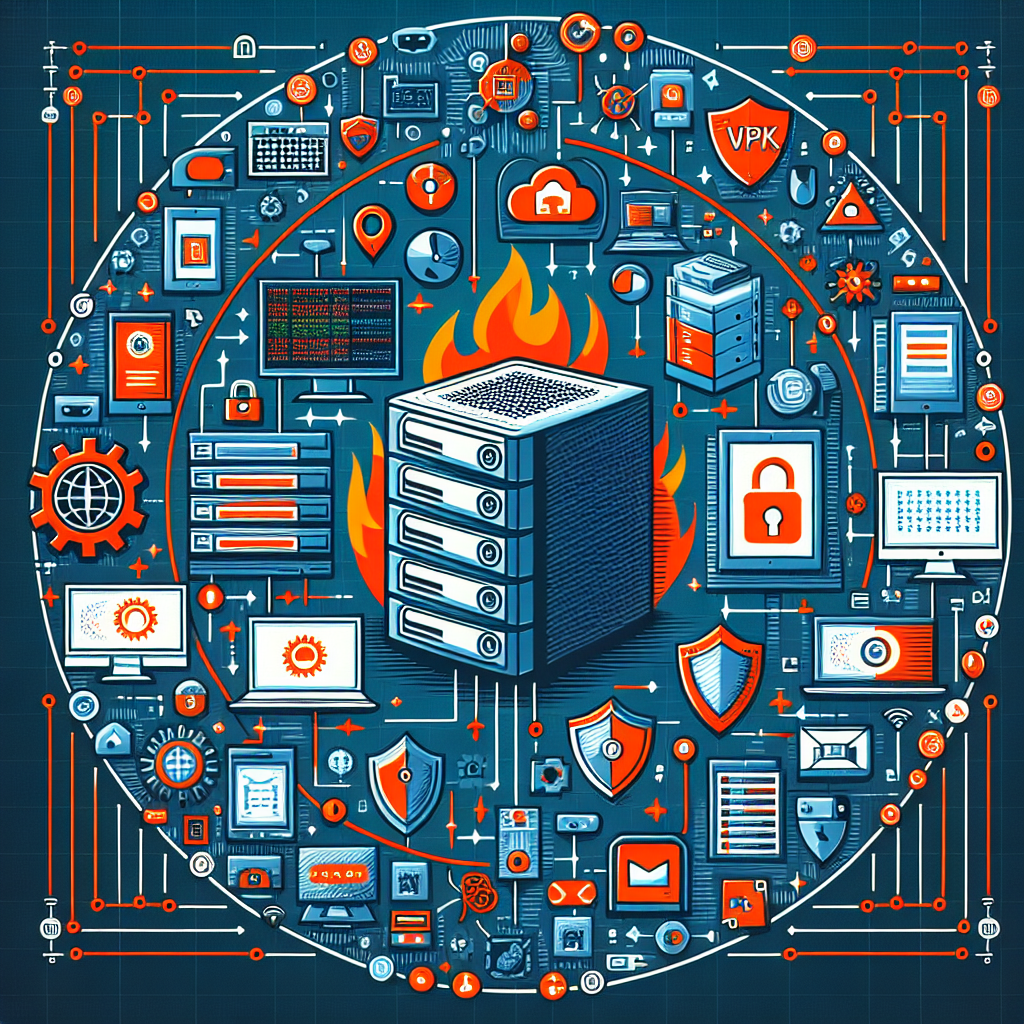Your cart is currently empty!
Tag: Practices

Disaster Recovery Best Practices: What Every Business Needs to Know
Disasters can strike at any time, whether it’s a natural disaster like a hurricane or earthquake, or a man-made disaster like a cyber attack or data breach. When a disaster does occur, it’s crucial for businesses to have a solid disaster recovery plan in place to ensure they can quickly recover and resume normal operations. Here are some best practices that every business needs to know when it comes to disaster recovery.1. Identify potential risks: The first step in creating a disaster recovery plan is to identify the potential risks that your business may face. This could include natural disasters, such as floods or fires, as well as man-made disasters like cyber attacks or equipment failures. By understanding the risks your business faces, you can develop a plan that addresses these specific threats.
2. Backup your data: One of the most important aspects of a disaster recovery plan is backing up your data. This includes regularly backing up all important files and documents to an offsite location, such as a cloud storage service or external hard drive. By regularly backing up your data, you can ensure that you can quickly recover and restore your information in the event of a disaster.
3. Develop a communication plan: In the event of a disaster, communication is key. It’s important to have a communication plan in place that outlines how you will communicate with employees, customers, and other key stakeholders during a disaster. This could include setting up a phone tree, creating a list of emergency contact information, and establishing a central communication hub where updates can be posted.
4. Test your plan regularly: Once you have a disaster recovery plan in place, it’s crucial to test it regularly to ensure that it works effectively. This could involve running simulated disaster scenarios, such as a mock cyber attack or data breach, to see how well your plan holds up under pressure. By testing your plan regularly, you can identify any weaknesses or gaps that need to be addressed.
5. Train your employees: Another important aspect of disaster recovery planning is training your employees on what to do in the event of a disaster. This could include conducting regular training sessions on the disaster recovery plan, as well as providing employees with the tools and resources they need to respond effectively during a crisis. By ensuring that your employees are prepared, you can minimize the impact of a disaster on your business.
In conclusion, disaster recovery planning is essential for every business, no matter its size or industry. By following these best practices, you can ensure that your business is prepared to respond effectively in the event of a disaster and quickly recover and resume normal operations. Remember, it’s better to be prepared and never need your disaster recovery plan than to be caught off guard when a disaster strikes.

Best Practices for Drafting and Managing Service Level Agreements (SLAs)
A Service Level Agreement (SLA) is a contractual agreement between a service provider and their customer that outlines the level of service that will be provided. SLAs are essential for ensuring that both parties have a clear understanding of expectations and responsibilities.When drafting and managing SLAs, it is important to follow best practices to ensure that the agreement is effective and meets the needs of both parties. Here are some best practices for drafting and managing SLAs:
1. Define clear and measurable metrics: When drafting an SLA, it is important to define clear and measurable metrics that will be used to track the performance of the service provider. These metrics should be specific, relevant, achievable, and time-bound. By clearly defining these metrics, both parties will have a clear understanding of what is expected.
2. Include performance targets: In addition to defining metrics, it is important to include performance targets in the SLA. These targets should outline the level of service that is expected from the service provider. By including performance targets, both parties will have a clear understanding of what is expected and can work towards achieving these targets.
3. Include remedies for non-performance: It is important to include remedies for non-performance in the SLA. These remedies should outline what steps will be taken if the service provider fails to meet the agreed-upon performance targets. By including remedies for non-performance, both parties will have a clear understanding of the consequences of failing to meet the agreed-upon performance targets.
4. Regularly review and update the SLA: SLAs should be regularly reviewed and updated to ensure that they continue to meet the needs of both parties. By regularly reviewing and updating the SLA, both parties can ensure that the agreement remains relevant and effective.
5. Communication is key: Communication is key when managing SLAs. Both parties should communicate regularly to ensure that the agreement is being followed and that any issues are addressed promptly. By maintaining open and transparent communication, both parties can work together to ensure that the SLA is effective.
In conclusion, drafting and managing SLAs requires careful planning and attention to detail. By following best practices such as defining clear and measurable metrics, including performance targets, including remedies for non-performance, regularly reviewing and updating the SLA, and maintaining open communication, both parties can ensure that the agreement is effective and meets their needs.

Preparing for the Unexpected: Best Practices in Business Continuity Management
In today’s fast-paced and ever-changing business environment, it is crucial for organizations to be prepared for the unexpected. Whether it be a natural disaster, a cyber-attack, or a global pandemic, having a solid business continuity management plan in place can mean the difference between surviving a crisis and shutting down operations.Business continuity management (BCM) is the process of creating and implementing a plan to ensure that an organization can continue to operate during and after a disaster or crisis. It involves identifying potential risks, developing strategies to mitigate those risks, and putting in place measures to ensure the organization’s critical functions can continue to operate.
One of the key components of a successful BCM plan is risk assessment. Organizations need to identify the potential risks they face, whether it be physical risks such as natural disasters or cyber risks such as hacking or data breaches. By understanding the risks they face, organizations can develop strategies to mitigate them and ensure they are prepared for any eventuality.
Another important aspect of BCM is developing a crisis communication plan. In the event of a disaster or crisis, effective communication is essential to ensure that employees, customers, and stakeholders are kept informed and updated on the situation. This includes having clear lines of communication in place, such as a designated spokesperson and communication channels, as well as a plan for how and when information will be shared.
Having a backup plan in place is also crucial for business continuity. This includes backing up critical data and systems, having alternative suppliers or vendors in place, and having a plan for relocating operations if necessary. By having these backup plans in place, organizations can minimize the impact of a crisis and ensure that they can continue to operate even in the face of adversity.
Regular testing and training are also important components of a successful BCM plan. Organizations should regularly test their plans and procedures to ensure they are effective and up to date. Additionally, employees should be trained on their roles and responsibilities in the event of a crisis so that they can respond quickly and effectively when disaster strikes.
In conclusion, preparing for the unexpected is essential for organizations to ensure they can continue to operate in the face of a crisis. By implementing best practices in business continuity management, organizations can identify potential risks, develop strategies to mitigate them, and ensure they are prepared for any eventuality. By investing in BCM, organizations can not only protect their business but also build resilience and ensure their long-term success.

Best Practices for Network Management in Small Businesses
Network management is crucial for small businesses to ensure smooth operations and seamless connectivity. With the increasing reliance on technology, it is essential for small businesses to implement best practices for network management to prevent downtime, security breaches, and inefficiencies. Here are some best practices for network management in small businesses:1. Regularly update software and hardware: It is important to keep all software and hardware up to date to ensure optimal performance and security. Regular updates help to patch vulnerabilities and protect against cyber threats.
2. Implement network monitoring tools: Network monitoring tools help small businesses to keep track of their network performance, identify potential issues, and troubleshoot problems before they escalate. These tools provide real-time insights into network traffic, bandwidth usage, and device performance.
3. Secure your network: Small businesses should implement robust security measures to protect their network from cyber threats. This includes using firewalls, antivirus software, encryption, and strong passwords. Regularly monitoring network traffic and conducting security audits can help identify and address vulnerabilities.
4. Backup data regularly: Data loss can have a significant impact on small businesses. It is important to regularly backup data to prevent loss in case of a network failure, cyber attack, or hardware malfunction. Cloud storage solutions are a convenient and secure way to backup data.
5. Create a network management plan: Small businesses should have a network management plan in place to outline procedures for managing their network infrastructure. This plan should include policies for network access, security measures, device management, and disaster recovery.
6. Train employees on network security: Employees are often the weakest link in network security. Small businesses should provide training on best practices for network security, such as how to recognize phishing emails, use strong passwords, and avoid accessing insecure websites.
7. Monitor network performance: Small businesses should regularly monitor their network performance to identify potential bottlenecks and performance issues. This can help optimize network efficiency and ensure smooth operations.
8. Outsource network management: Small businesses may benefit from outsourcing their network management to a managed service provider (MSP). MSPs have the expertise and resources to manage network infrastructure, monitor performance, and address security threats proactively.
By implementing these best practices for network management, small businesses can ensure a secure, reliable, and efficient network infrastructure. Investing in network management will help small businesses to prevent costly downtime, protect against cyber threats, and support growth and innovation.

Avoiding Data Disasters: Best Practices for Data Backup and Recovery
In today’s digital age, data is one of the most valuable assets that businesses possess. From customer information to financial records, companies rely on data for everyday operations. However, data disasters can strike at any moment, causing irreversible damage and significant financial loss. That’s why it’s crucial for businesses to have a solid data backup and recovery plan in place.Data disasters can come in many forms, including hardware failures, cyber-attacks, natural disasters, and human error. These incidents can result in data loss, downtime, and disruption to business operations. To avoid such disasters, it’s essential for businesses to implement best practices for data backup and recovery.
One of the most important steps in data backup and recovery is to regularly back up your data. This means making copies of your data and storing them in a secure location. It’s recommended to have both onsite and offsite backups to ensure that your data is protected in case of a disaster. Cloud storage solutions are also a popular option for securely storing backups offsite.
Another best practice for data backup and recovery is to test your backups regularly. It’s not enough to simply create backups – you need to ensure that they can be successfully restored in the event of a data loss. Regularly testing your backups will help you identify any issues and make necessary adjustments to your backup plan.
In addition, it’s important to have a data recovery plan in place. This plan should outline the steps to take in the event of a data disaster, including who is responsible for managing the recovery process and how to restore data quickly and efficiently. Having a well-defined data recovery plan will help minimize downtime and ensure that your business can quickly resume operations after a data disaster.
It’s also essential to implement security measures to protect your backup data. Encrypting your backups and restricting access to them will help prevent unauthorized access and ensure the confidentiality and integrity of your data. Regularly updating your security measures and monitoring for any suspicious activity will also help prevent data breaches and ensure the safety of your backup data.
In conclusion, data backup and recovery are essential components of a robust data protection strategy. By following best practices for data backup and recovery, businesses can minimize the risk of data disasters and ensure the safety and availability of their valuable data. Investing in a solid backup and recovery plan will not only protect your business from potential data loss but also provide peace of mind knowing that your data is secure and easily recoverable in the event of a disaster.

Improving Efficiency in Technical Support: Best Practices and Strategies
Technical support plays a crucial role in ensuring the smooth operation of any business that relies on technology. From fixing software glitches to troubleshooting hardware issues, the technical support team is responsible for keeping everything running smoothly. However, providing efficient technical support can be a challenge, especially when dealing with a high volume of requests and complex issues.To improve efficiency in technical support, companies need to implement best practices and strategies that can help streamline processes and enhance the overall support experience for both customers and support agents. Here are some tips on how to improve efficiency in technical support:
1. Implement a ticketing system: One of the first steps in improving efficiency in technical support is to implement a ticketing system. This system allows support agents to track and prioritize incoming requests, assign them to the appropriate team members, and monitor the status of each ticket. By centralizing all support requests in one place, companies can ensure that nothing falls through the cracks and that every issue is addressed promptly.
2. Provide self-service options: Another way to improve efficiency in technical support is to provide customers with self-service options. This can include a knowledge base with troubleshooting guides, FAQs, and instructional videos that customers can use to resolve common issues on their own. By empowering customers to solve their own problems, companies can reduce the number of support requests and free up support agents to focus on more complex issues.
3. Use automation tools: Automation tools can help streamline repetitive tasks in technical support, such as ticket routing, response generation, and data entry. By automating these tasks, support agents can save time and focus on more high-value activities, such as problem-solving and customer interaction. Additionally, automation tools can help improve response times and ensure that no request goes unanswered.
4. Provide ongoing training and support: Continuous training and support are essential for ensuring that support agents have the skills and knowledge they need to effectively resolve technical issues. Companies should invest in training programs, workshops, and certifications for their support team to keep them up-to-date on the latest technologies and best practices in technical support.
5. Monitor and analyze performance metrics: To measure the efficiency of technical support, companies should monitor and analyze key performance metrics, such as response time, resolution time, customer satisfaction, and ticket volume. By tracking these metrics, companies can identify areas for improvement and make data-driven decisions to optimize their support processes.
In conclusion, improving efficiency in technical support requires a combination of best practices and strategies that focus on streamlining processes, empowering customers, and providing ongoing training and support for support agents. By implementing these tips, companies can enhance the overall support experience and ensure that technical issues are resolved quickly and effectively.

Best Practices for Network Security and Management
In today’s digital age, network security and management have become crucial components of any organization’s IT infrastructure. With cyber threats becoming more sophisticated and prevalent, it is imperative for businesses to implement best practices to protect their networks from potential breaches and attacks.Here are some key best practices for network security and management that organizations should consider:
1. Implement a robust firewall: A firewall acts as a barrier between your network and external threats, filtering out potentially harmful traffic. It is essential to configure and regularly update your firewall to ensure that it is effectively protecting your network from unauthorized access.
2. Use strong encryption: Encrypting data in transit and at rest is essential to protect sensitive information from being intercepted or accessed by unauthorized users. Implementing strong encryption protocols such as SSL/TLS can help secure your network communications.
3. Regularly update and patch systems: Keeping your network infrastructure up-to-date with the latest security patches and updates is essential to protect against known vulnerabilities. Hackers often exploit outdated software and systems to gain unauthorized access to networks.
4. Implement multi-factor authentication: Multi-factor authentication adds an extra layer of security by requiring users to provide multiple forms of identification before accessing the network. This helps prevent unauthorized access, even if login credentials are compromised.
5. Monitor network traffic: Monitoring network traffic in real-time can help detect and respond to suspicious activities or anomalies that may indicate a potential security breach. Implementing intrusion detection and prevention systems can help identify and mitigate threats before they escalate.
6. Conduct regular security audits: Performing regular security audits and assessments can help identify potential vulnerabilities and weaknesses in your network infrastructure. This allows organizations to proactively address security issues before they are exploited by cybercriminals.
7. Educate employees on cybersecurity best practices: Human error is often a significant factor in security breaches, so it is essential to educate employees on cybersecurity best practices. Training employees on how to recognize and respond to phishing emails, secure passwords, and protect sensitive information can help prevent security incidents.
8. Implement a disaster recovery plan: In the event of a security breach or data loss, having a robust disaster recovery plan in place is essential to minimize downtime and mitigate the impact on your organization. Regularly testing and updating your disaster recovery plan ensures that you can quickly recover from any security incidents.
By implementing these best practices for network security and management, organizations can enhance their cybersecurity posture and protect their valuable data and assets from potential threats. Investing in robust security measures and staying vigilant against emerging threats is essential to safeguarding your network infrastructure in today’s digital landscape.

Proactive Maintenance Best Practices for Long-Term Equipment Reliability
Proactive maintenance is a key practice in ensuring the long-term reliability of equipment. By implementing proactive maintenance best practices, organizations can prevent breakdowns, reduce downtime, and extend the lifespan of their equipment. In this article, we will discuss some of the best practices for proactive maintenance that can help organizations achieve long-term equipment reliability.1. Develop a maintenance schedule: One of the first steps in implementing proactive maintenance is to develop a maintenance schedule for each piece of equipment. This schedule should outline the frequency of maintenance tasks, such as inspections, lubrication, and calibration, as well as the specific tasks that need to be performed. By following a regular maintenance schedule, organizations can identify and address potential issues before they lead to equipment failure.
2. Conduct regular inspections: Regular inspections are essential for identifying potential issues early on. Inspections should be conducted by trained personnel who are familiar with the equipment and its maintenance requirements. During inspections, personnel should look for signs of wear and tear, leaks, loose fittings, and other issues that could impact the reliability of the equipment.
3. Keep detailed maintenance records: Keeping detailed maintenance records is crucial for tracking the maintenance history of each piece of equipment. These records should include information such as maintenance tasks performed, parts replaced, and any issues that were identified during inspections. By maintaining accurate records, organizations can track the performance of their equipment over time and identify trends that may indicate potential issues.
4. Implement predictive maintenance techniques: Predictive maintenance techniques, such as vibration analysis, thermography, and oil analysis, can help organizations predict when equipment failure is likely to occur. By monitoring key indicators of equipment health, organizations can identify potential issues before they lead to breakdowns and take corrective action to prevent costly repairs.
5. Train maintenance personnel: Proper training is essential for ensuring that maintenance personnel are equipped to perform proactive maintenance tasks effectively. Training should cover topics such as equipment operation, maintenance procedures, and safety protocols. By investing in training for maintenance personnel, organizations can ensure that maintenance tasks are performed correctly and efficiently, leading to improved equipment reliability.
6. Invest in quality parts and materials: Using quality parts and materials is essential for maintaining the reliability of equipment. Low-quality parts can lead to premature failure and costly repairs, while high-quality parts can help extend the lifespan of equipment. Organizations should work with reputable suppliers to ensure that they are using parts and materials that meet the required specifications for their equipment.
In conclusion, proactive maintenance is essential for ensuring the long-term reliability of equipment. By following these best practices, organizations can prevent breakdowns, reduce downtime, and extend the lifespan of their equipment. By developing a maintenance schedule, conducting regular inspections, keeping detailed maintenance records, implementing predictive maintenance techniques, training maintenance personnel, and investing in quality parts and materials, organizations can achieve long-term equipment reliability.

Disaster Recovery Best Practices for Small and Medium-sized Businesses
Disasters can strike at any time, leaving businesses vulnerable to loss of data, operations, and revenue. Small and medium-sized businesses (SMBs) are particularly at risk, as they may not have the resources or expertise to quickly recover from a disaster. That’s why having a solid disaster recovery plan in place is crucial for SMBs to ensure business continuity and minimize the impact of a disaster.Here are some best practices for disaster recovery that SMBs should consider implementing:
1. Conduct a risk assessment: Before creating a disaster recovery plan, SMBs should assess their risks and vulnerabilities. This includes identifying potential threats such as natural disasters, cyberattacks, and equipment failures. Understanding these risks will help SMBs prioritize their recovery efforts and allocate resources accordingly.
2. Create a comprehensive disaster recovery plan: Once the risks have been identified, SMBs should create a detailed disaster recovery plan that outlines the steps to take in the event of a disaster. This plan should include procedures for data backup and recovery, communication with employees and customers, and restoring operations as quickly as possible.
3. Regularly backup data: Data is a critical asset for SMBs, so it’s important to regularly backup data to prevent loss in the event of a disaster. SMBs should consider using cloud-based backup services to ensure data is securely stored offsite and easily accessible in the event of a disaster.
4. Test the disaster recovery plan: It’s not enough to just have a disaster recovery plan in place – SMBs should regularly test the plan to ensure it works effectively. Conducting drills and simulations will help identify any gaps or weaknesses in the plan and allow SMBs to make necessary adjustments.
5. Train employees: Employees play a crucial role in disaster recovery, so it’s important to train them on the disaster recovery plan and their roles and responsibilities in the event of a disaster. This will help ensure a coordinated and efficient response when a disaster strikes.
6. Stay informed: Stay informed about potential threats and disasters that could impact the business. Monitor weather reports, cybersecurity alerts, and other sources of information to stay ahead of potential risks and take proactive measures to protect the business.
By following these best practices, SMBs can better prepare for and recover from disasters, ensuring business continuity and minimizing the impact on operations, data, and revenue. Disaster recovery planning is a critical investment for SMBs to protect their livelihood and ensure long-term success.

Case Studies in Successful IT Outsourcing: Lessons Learned and Best Practices
Outsourcing IT services has become increasingly popular in recent years as companies look to reduce costs, increase efficiency, and focus on their core competencies. However, not all outsourcing arrangements are successful. In fact, many companies have experienced challenges and setbacks when outsourcing their IT functions.To shed some light on this topic, let’s take a look at some case studies of successful IT outsourcing and the lessons learned and best practices that can be applied to future outsourcing projects.
Case Study 1: IBM and Procter & Gamble
One of the most famous examples of successful IT outsourcing is the partnership between IBM and Procter & Gamble. In 2003, Procter & Gamble outsourced its IT infrastructure and services to IBM in a deal worth over $3 billion. The partnership allowed Procter & Gamble to focus on its core business of consumer goods while IBM managed its IT functions.
Lessons Learned:
– Clear communication and alignment of goals are crucial for a successful outsourcing partnership.
– Regular monitoring and performance tracking help ensure that both parties are meeting their obligations.
– Flexibility and adaptability are key in responding to changing business needs and technology trends.
Best Practices:
– Establish a strong partnership based on trust, transparency, and mutual respect.
– Define clear objectives and expectations from the start to avoid misunderstandings and conflicts.
– Regularly review and assess the performance of the outsourcing arrangement to identify areas for improvement.
Case Study 2: Google and Accenture
Google outsourced its IT support services to Accenture, a leading global consulting and technology services company, to enhance its customer support capabilities. The partnership allowed Google to leverage Accenture’s expertise in IT services and focus on its core business of search and advertising.
Lessons Learned:
– Choosing the right outsourcing partner with the necessary skills, experience, and resources is critical for success.
– Effective communication and collaboration between the client and the outsourcing provider are essential for achieving shared goals.
– Continuous evaluation and feedback help ensure that the outsourcing arrangement is meeting business objectives.
Best Practices:
– Conduct thorough due diligence and evaluation of potential outsourcing partners to ensure compatibility and alignment with business goals.
– Establish clear processes and guidelines for communication, decision-making, and issue resolution.
– Regularly review and assess the performance of the outsourcing provider to identify areas for improvement and optimization.
In conclusion, successful IT outsourcing requires careful planning, effective communication, and collaboration, as well as a strong partnership based on trust and mutual respect. By learning from case studies of successful outsourcing arrangements and applying best practices, companies can maximize the benefits of outsourcing and achieve their business objectives.
